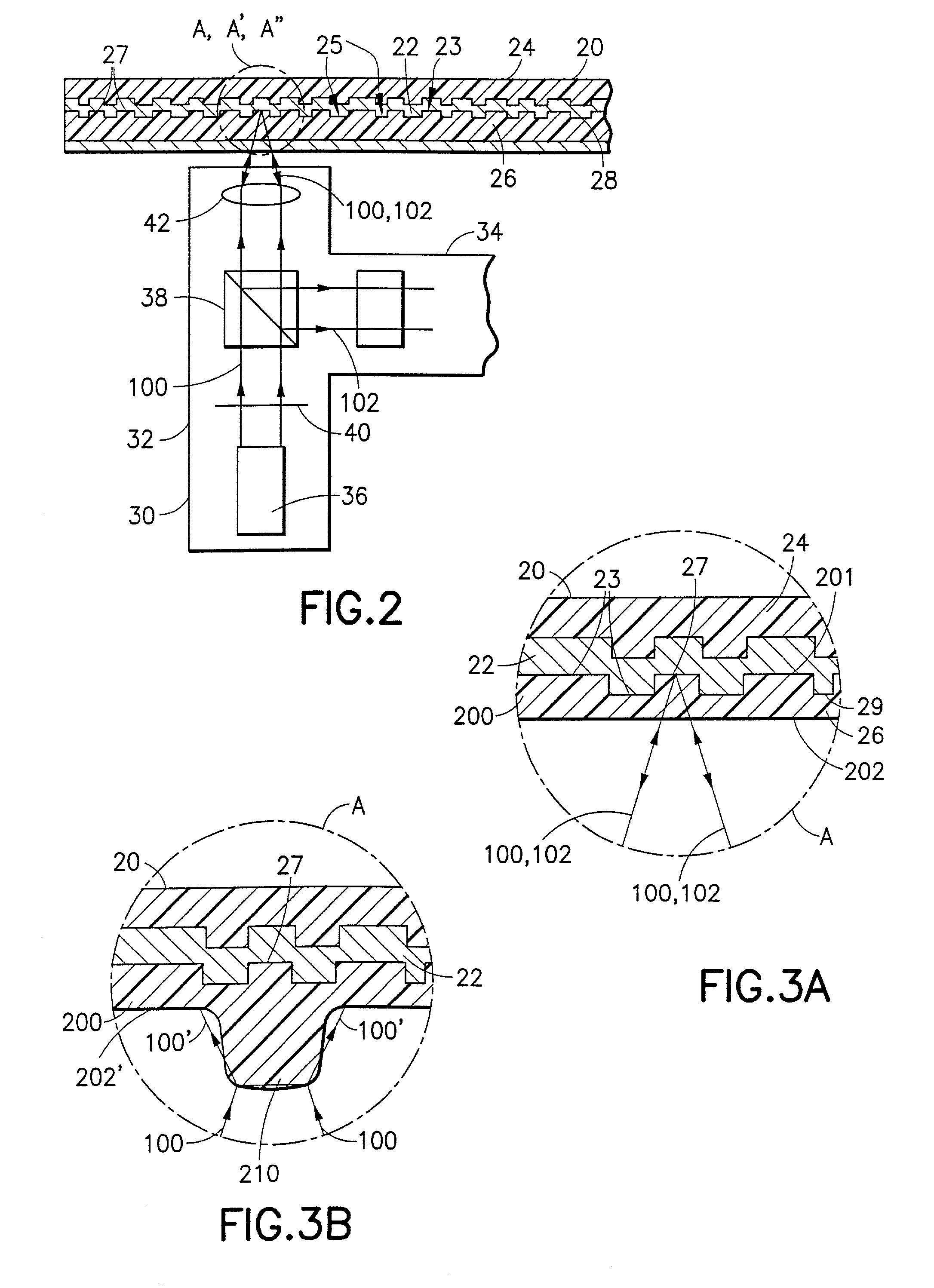Methods and apparatus for rendering an optically encoded medium unreadable
an optical encoded medium and unreadable technology, applied in the field of optical encoded media unreadable methods and apparatuses, can solve the problems of unfavorable protection mechanisms, unfavorable protection mechanisms that rely on computer software to implement, and unfavorable protection mechanisms that can be defeated by additional computer softwar
- Summary
- Abstract
- Description
- Claims
- Application Information
AI Technical Summary
Benefits of technology
Problems solved by technology
Method used
Image
Examples
first embodiment
[0043] Referring now to FIGS. 3A and 3B, there is shown an enlarged cross-sectional view of a portion A of the optical disk 20 in accordance with this invention. The optical disk 20 is constructed so as to include a surface relief photopolymer layer 200. The surface relief photopolymer layer 200 is comprised of one or more polymers, such as, by example, an azobenzene containing polymer. It is known that an azobenzene containing polymer is capable of exhibiting a surface deformations in response to a presence of an optical intensity gradient.
[0044] Reference in this regard may be had to an article entitled "Gradient force: The mechanism for surface relief grating formation in azobenzene functionalized polymers", Applied Physics Letters, Vol. 72, No. 17, pps. 2096-2098, Apr. 27, 1998, J. Kumar et al. The authors report on the derivation of a model for the formation of holographic surface relief gratings in azobenzene functionalized polymers. Forces leading to migration of polymer chai...
third embodiment
[0059] Referring now to FIGS. 5A and 5B, there is shown an enlarged cross-sectional view of Section A" of the optical disk 20" in accordance with this invention. The optical disk 20" in this embodiment of the invention is substantially similar to the optical disk 20 described previously with reference to FIG. 2, except as otherwise noted below. As seen in FIGS. 5A and 5B, the optical disk 20" in accordance with this embodiment includes a substrate 400 which may be formed from a polycarbonate material disposed generally against the reflective surface 28" of the reflective layer 22" in the optical disk. Included between the substrate 400 and the reflective surface 28" of the disk 20" are regions or pockets 402A, 402B of an uncured photopolymer 402. As shown in FIG. 5A, the photopolymer 402 is disposed within the pits 27" formed in the reflective layer 22" of the optical disk 20". In an uncured state, the index of refraction of the photopolymer 402 is such that the interrogating beam 1...
example # 1
EXAMPLE #1
[0073] A solution of poly-p-(hydroxystyrene) (5 .mu.m), ethanol (10 mL), crystal violet lactone (200 mg) and NMP (3.0 mL) was prepared. A few drops were applied to a glass slide and the mixture was allowed to air dry at room temperature. The film which formed was soft and tacky to the touch but it was colorless. Color formation was followed over the course of several days through the use of a spectrophotometer.
3 Time (hours) Optical Density (607 nm) 0 0 18 0.181 85 0.242
[0074] Since the film formed in example #1 was soft and tacky formaldehyde was added to cross link the phenolic polymer.
PUM
| Property | Measurement | Unit |
|---|---|---|
| linear velocity | aaaaa | aaaaa |
| wavelengths | aaaaa | aaaaa |
| spot size | aaaaa | aaaaa |
Abstract
Description
Claims
Application Information
 Login to View More
Login to View More - R&D
- Intellectual Property
- Life Sciences
- Materials
- Tech Scout
- Unparalleled Data Quality
- Higher Quality Content
- 60% Fewer Hallucinations
Browse by: Latest US Patents, China's latest patents, Technical Efficacy Thesaurus, Application Domain, Technology Topic, Popular Technical Reports.
© 2025 PatSnap. All rights reserved.Legal|Privacy policy|Modern Slavery Act Transparency Statement|Sitemap|About US| Contact US: help@patsnap.com



